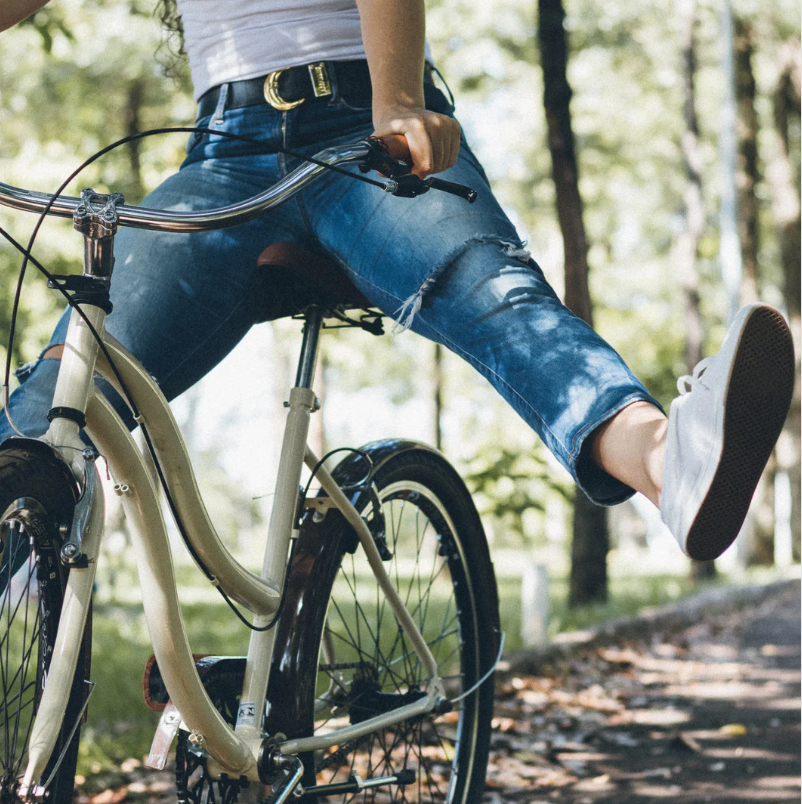Last weekend, Karl and I decided to ride our bikes to the lake on the outskirts of town. We hopped on our bikes and pedaled along the gushing river, past blossoming trees, over a dam, and to the wildlife refuge that encircles the lake. However, the longer we rode, the further I fell behind. I pedaled until I couldn’t breathe. No matter how hard I tried, I couldn’t keep up with my partner (who, I must say, is a talented cyclist). I’m not out of shape, so why couldn’t I keep up with him? My frustration with myself mounted. However, I didn’t suspect that I wasn’t using the right tools for the job.
To lighten the mood, we switched bikes on the way back for about a quarter-mile. I had never been on a bike like his before. “Bluefin,” as we like to call it, was as light as air and shot down the path like a dolphin riding the waves. Behind me, however, Karl was struggling with the bike that I’d had since high school.
After a comedy of errors, including a flat tire and bike pump that quit working on the job, Karl went for the car, and I took a walk.
I brought the bike to the shop the next day and had them service the bike. A bit of elbow grease, new tire tubes, and a good tune-up helped matters but didn’t fix them. “It’s the best department store bike I’ve ever ridden,” the shop manager smiled, “and will get you from A to B, and I’ve no doubt this has served you well over the years. But if you’re going to get into cycling more, you’ll need the right tools for the job. You’re going to want to invest in a better bike, or riding will be a struggle, and you’ll probably end up quitting.”
Since then, I’ve found a bike that I’ve fallen in love with. It’s been almost impossible to pry me off of it, and I’ve been exploring bike trails left and right. Cycling had never been my favorite activity until I brought this bike home. Now, it feels like I’m riding on a hawk’s back, swooping and soaring, free and strong.
I just needed the right tools for the job.
Do You Have the Right Tools for the Job?
Life, like a bike ride, can be challenging. However, if we have the right tools and people alongside us to help us navigate our life’s path, we will be more likely to enjoy the ride. Healing from things like trauma, abuse, and grief can be one of the most challenging journeys to take. Here are a few “tools” that can help you navigate that trail successfully.
11 Tools to Help You
1. Gears
Find people you connect and click with and who are your closest allies. Be sure to spend quality time with them and stay connected as often as possible. These people may be family, friends, pastors, or support group members. When you are struggling to get up a hill, these people will be the ones to encourage you and help you reach your goal. In turn, you will find ways to help others facing similar circumstances, and reaching out a helping hand to them is one of the best ways for a heart to heal.
2. Handlebars
Healing is rough terrain, and it can feel like you’re getting pulled to the right and left. Speaking regularly with a counselor can help keep you moving forward on a less nausea-inducing track. If you are experiencing PTSD from trauma, seek out an EMDR certified counselor who can help you overcome that situation. Counseling can open your eyes to your strengths, areas where you can grow, and ways that you can accomplish those things without getting pulled off track.
3. Brakes
Remember that it’s okay to set limits for yourself. It’s okay to say “no” to requests from others that stretch you too thin or trigger you. It is healthy to put distance between yourself and abusive people or people whose presence does not allow positive mental health. Also, let yourself put on the brakes and get rest when you need it. Be sure to get a good night’s sleep every night. Rest can sometimes be one of the most productive things you can do!
4. Pedals
Get into a routine. Waking up and going to sleep at the same time every day and scheduling your work and free hours to be consistent can help your mind settle into a rhythm that reduces stress and can help with stabilizing emotions.

5. Bell
Just like you don’t want to hide the fact that you’re fast approaching someone, you don’t want to hide and bury your emotions. Difficult emotions can be hard to experience, especially at inconvenient times, and it’s tempting to squash or ignore them. However, those same emotions will run right across the road in front of you and knock you off balance if you don’t face them.
Those emotions will also keep jabbing you in the booty like a bike without a seat until you address them. Make time to sit with these emotions and feel through them. If these thoughts and feelings become too overwhelming, reach out to your primary care physician for some additional, temporary tools to help you overcome them.
6. Wheels/Tires
Keep rolling! It’s essential to get a healthy amount of exercise, four to five times a week. This keeps your body healthy, but it helps with mental health. Studies have shown that exercises such as walking, running, hiking, and biking create the same bilateral stimulation in the brain that EMDR therapy does for people overcoming PTSD. Exercise is a great way to start to process events that you experience.
7. Repair Kit
Stay away from coping mechanisms such as alcohol, drugs, cigarettes, or excessive eating. While these things may seem to offer temporary relief from your emotions, they make things worse in the long term. Like a tire blowing out on a bike, they can cause you to skid out of control, and repairing the damage can be costly and time-consuming.
8. Water Bottle
Keep yourself hydrated and eat nourishing foods. When exhausted or hurting, it’s easy to skip a meal or overeat the wrong thing. Be mindful of what you are eating and drinking, and give your body the fuel necessary to keep moving forward.
9. Reflectors
When we’re riding through the darkness, we need light to keep us safe. Spending time in prayer, reading the Bible, and attending church or a Bible study group can help shine light and hope into your situation. Clinging to God’s Word and your faith in Him can help you through the longest nights and most difficult days. When no one else seems to be there, He is present. He is the light that shines when all other lights have gone out.
10. Helmet
Take time to reinvent yourself and give yourself a purpose. Find a goal to work toward and start peddling in that direction. You’ll discover things about yourself that you never knew, find strengths you didn’t know you had, and realize who you want to become.
11. Seat and Bike Shorts
Be kind to yourself. When you spend time in the saddle, you will gain some sore muscles no matter how much padding you wear. It’s inevitable. Life is guaranteed to make you ache sometimes. That doesn’t mean that there is anything wrong with you. You are not broken or damaged, and you are not a burden. Have patience on the journey. It takes time and effort. Recognize that progress isn’t linear: Instead of a straight trek uphill, it’s more of a winding road. Be patient, prioritize taking care of yourself, and keep on persevering.
What’s Your Story?
What other tools can you think of to help you reach your goals and overcome obstacles? Which things have helped you navigate life’s twists and turns so far? Let us know in the comments!
Ⓒ 2022, Lainey La Shay.


No responses yet